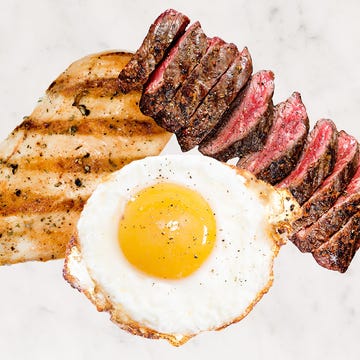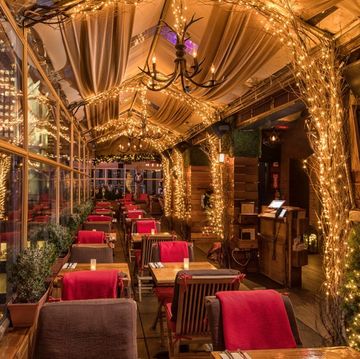Esquire's Best New Restaurants 2011

The Best of 2011

Everyone in the food world is always trying to pinpoint the trend of the moment. What's hot? What's next? What's going to fill seats? But right now, there is a trend mash going on. The best chefs and restaurateurs are leaving behind the recent comfort-food fad and heading off in strange new directions — pop-ups, comebacks, smaller small plates, bigger big plates, richer dishes, light touches. It's all a little confusing, and much of it is wonderful. We're here to celebrate the wonderful.
Restaurant of the Year: Michael Mina
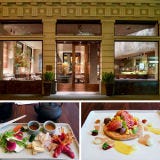
San Francisco
After three decades of compiling this list, most years I know which one will be the very best Best New Restaurant after fifteen minutes.
In the case of Michael Mina, I was delighted to be back in the airy space, lighted by the soft, foggy San Francisco sun, that had long been Aqua, which Mina, the chef, helped open in 1991. Since then he has built an empire of mostly high-end restaurants from Atlantic City to Vegas, a rampant expansionism that made me lose interest in him as a working chef. So Mina's return to his roots, at this stylish namesake where he swears he'll be cooking most of the time, was promising news.
Mina's Web site says his food has "his sensibilities with Japanese ingredients and a French influence," which tells you little — I pictured a high-mileage Citroën with cupholders. But Mina has learned from the global kitchen, and in this civilized dining room, he shows it. His Alaskan halibut is warmed in a ginger-carrot broth with steamed dumplings. He makes a shabu shabu of foie gras in a dashi broth with Asian mushrooms, and his Maine lobster pie comes with smoked potato, corn pudding, and roasted tomatoes — the best New England dish on the West Coast. If Mina is there the night you visit, you'll have one of the great meals of your life by an American master.
252 California Street; 415-397-9222; michaelmina.net
Salinas
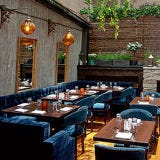
New York
Ten years ago, Luis Bollo's restaurant Meigas in lower Manhattan was a hallmark of modern Iberian food. As the food world fawned over the now-legendary El Bulli in Spain, Bollo earned fans of his own innovations. In 2000, it appeared on this list.
In 2001, with downtown ruined by the terrorist attacks, Bollo shuttered his restaurant. "I was devastated," he says. Now, a decade later, he gives us Salinas, and it's a remarkable return. A casual place with a patio out back and a tapas bar up front, Salinas offers a menu that begins with slices of salty-sweet jamón Iberico, moves on to rosejat rápida — crispy noodles, chicken breast, chorizo, and cockles with saffron aioli — and culminates with porcella, a meltingly soft suckling pig with grilled peaches and a PX sherry reduction. The dish is a triumph of tradition and pitch-perfect technique.
"Everything to do with food has gotten better," Bollo says of New York since 9/11. "Even fast food, because the competition is much higher. Restaurants have become more casual, but the quality is much higher. We didn't have many farmers' markets back then; now I can get anything I need so that I do not have to compromise the real flavors of Spanish cooking."
Latino cuisine has achieved a critical mass that sets it squarely in the mainstream, and few chefs have a better heritage and creative spirit than Bollo. El Bulli closed this year, and Salinas is showing how Spanish cuisine will sustain its eminence in the decade ahead.
136 Ninth Avenue; 212-776-1990; salinasnyc.com
Chef of the Year: John Sedlar
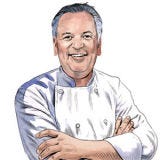
Playa, Los Angeles
Dear young chef: Congratulations on your graduation from culinary school! Unless you're busy competing on a TV show to become a celebrity chef, the smart move would be to apprentice yourself to a master like John Sedlar. He's twice your age, but he cooks with more verve and a deeper understanding of ingredients than any ten cooks you went to school with. He was born in Santa Fe and always married Mexican and South American food with a southern-California swagger — cutting edge neo-Latino cuisine. At Playa, his thrilling new restaurant, he presents reflexiones (his translation: "windows into memories"), thematic dishes that reflect his favorite chefs or movies — A Clockwork Orange was a recent theme. After you get your pig tattoo, order a mess of tortillas he calls "maize cakes" — one is made with wild mushrooms, black garlic, olives crushed to look like soil, L'Explorateur cheese, and mushroom foam. Try to assess the delicacy of a dish like corn custard with Cotija, black quinoa, and squash-blossom sauce, and learn how he builds flavor into piquillos relleños with Gruyère, golden raisins, and chorizo. Then beg him for a job peeling vegetables.
Best of luck, John
7360 Beverly Boulevard; 323-933-5300; playarivera.com
Boulud Sud
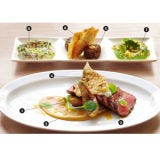
New York
Good chefs are of two kinds: those who forever refine what they already know and those who feverishly invent dishes to impress others. Great chefs, however, are those few in the class of Daniel Boulud, a master of embracing the exotic and taming it to his own expertise. Any chef can have ideas, but Boulud's inspirations are deeply personal and thus recognizably his, and that makes them exciting. He's proved this at all his restaurants, from his flagship, the ultradeluxe Daniel, to DBGB, where he elevates sausage to new heights. What's left to prove? That he is also one of the canniest interpreters of Provençal and Mediterranean food outside of Marseilles and Marrakesh. He uses the larder expertly, as demonstrated in his spicy lamb loin (above). It includes eggplant two ways: seared and glazed with honey (1), and in a perfectly seasoned puree (2). The tzatziki yogurt (3) is topped with cucumber and mint, and the lavash (4) is dusted with za'atar, an herb blend. On the side: chickpea falafel (5) with dried harissa yogurt (6), hummus made from fresh (green) chickpeas (7), and the best baba ghanoush you ever had (8). The dining room feels like a cross between the stateroom on a ship and Rick's Café Américain — both places you never want to leave.
20 West Sixty-fourth Street; 212-595-1313; danielnyc.com
Tico

Boston
Michael Schlow's long-standing reputation for sophisticated French-American cuisine at Radius and Italian food at Via Matta has naturally led the former New Yorker to tackle ... Latino food? "It hadn't really been embraced here," says the affable Schlow, who's been in town since 1995. "But as I've traveled, I found myself craving those flavors. I knew I couldn't be superauthentic and really didn't know if it would work at all. But I know that all Latino cooking this side of the Atlantic is about three things — salt, acid, and chiles. So I've adapted the regional cookeries of Mexico and Central and South America to my own tastes, which I hope make it unique."
Does it ever. In a big room of mismatched tables and a bar stocked with 124 different tequilas, Schlow offers plates meant to be shared, which you will have a tough time doing when the sweet corn with bacon, chiles, and basil arrives. Or the taco platter with two-texture beef and morita chiles, or the fried shrimp with pickled jalapeños. You want real-deal south of the border? Go south of the border. You want to experience the beautifully loco innovations of El Schlow? Go to Tico.
222 Berkeley Street; 617-351-0400; ticorestaurant.com
Grant Achatz: The Event

When the chef controls your experience this much, can you still enjoy your meal?
By Tom Chiarella
I admit that I went into Next, molecular chef Grant Achatz's revolutionary new fixed-menu restaurant in Chicago's West Loop, a little puffy with annoyance. Admittance requires a ticket — not a reservation, a ticket that you buy in advance. Very tough to get, too, this ticket. To buy it directly, you have to register your name for approval on the restaurant's Web site, nextrestaurant.com. Even then the odds are against you. Sixteen tables are released each day, and they sell out in three seconds. It took me five weeks of scrounging Craigslist to score a single seat.
The iteration of Achatz's Next menu that night? An eight-course "tour of Thailand." Not to sound like a four-year-old who likes only a specific brand of macaroni and cheese, but Thai food doesn't feed me; it has always seemed too familiar, an overcooked, overspiced, fishy chop-chop that produces a tight band of heartburn across the top of my abdomen. Add to that the fact that the waitstaff at Next was referring to Achatz as simply "Chef" — the way they do these days — so that he was starting to sound more like some winsome church mouse than the most-talked-about chef in the tweet-driven ethers of foodiedom. Plus my suspicion that soon I would be expected to chirp over how interesting the wines were. This is how annoyance rises up.
But then came the food, at which point Next supplants pretension with a playful and theatrical authority. Chef's choice: For two hundred bucks a head, everyone, every night, eats the same thing. Mouthfuls of street food served on a tablecloth made from a Thai news daily. Roast bananas stuffed with fried garlic, pickled shallots, and cilantro leaves. Sausage fermented in the alley next door. A prawn chip made with coriander and lime zest. Not a spring roll in the joint. With each course, a beverage pairing, but usually not wine — a guava-mango arrack punch, a gin-and-chrysanthemum cocktail served without ice. It starts to feel like a tropical heater simply because of the unpretentious booze.
By the fifth course, I'm making flat-out discoveries. Maybe they're truisms every foodie knows, but not me, not until one course is gracefully whisked clear and the table subtly reset: another aspect of Thailand is tilted forward once again. Discovery: Beef cheeks provide solace. Discovery: Curry need not overwhelm. Thai relishes, which in my past had seemed worth ignoring in their lifelong perch on the strip mall lazy Susan, are supposed to be funky, foul condiments, but can just as well be a sweet meal of smears by themselves. Coriander root and tiny leaves of the stuff atop a sweet caramel sauce. Nothing more, just coriander root! Had I been walking past this stuff in grocery stores all these years? Discovery: Watermelon consommé is the only real cleansing one's palate ever needs. Discovery: I like the texture of noodles, except in desserts.
I have what some might call a primitive relationship with food, and I've always felt overmatched by the intensity of top chefs and their nation of enthusiasts. Annoyed. But when I stood up at Next, I looked at the plate of the guy next to me — that catfish, those piquant roots. He took a bite and shook his head in wonder, then looked at me. "I know," I said. "Right?" he replied, saying everything, and nothing at all, as if we knew each other and what we could expect from the night. After we ate, we knew how much these moments were worth.
Congress
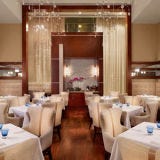
Austin
Austin has good barbecue (Iron Works), Mexican (Garrido's), even sushi (Uchiko), but a city this youthful, modern, and powerful has long needed the kind of fine-dining restaurant Rick Perry can brag about. Chef David Bull is no fanatical locavore, but he draws on the huge Texas cornucopia to create dishes like grilled sweetbreads with smoked poppy seeds in a buttermilk crema and beef tartare with fried oysters and truffles. There's a seven-course tasting menu that will tell you everything you need to know about Bull's talent; he can tell you why he's committed to Texas: "Texas is the underdog in the world of cuisine. Even today it conjures visions of barbecue and taco stands. And yet we have deep culinary roots with Mexico, but also a solid tradition of German cooking, cowboy chuck-wagon food, Italian, Native American, and an increasingly strong Asian influence. We have venison, antelope, peaches, figs, red snapper, oysters. It all makes my job a lot easier."
200 Congress Avenue; 512-827-2760; congressaustin.com
Hostess of the Year: Hannah Mary Marshall

Congress, Austin
Age: 24
Hometown: Houston
Education: Studying dietetics at Texas State University
Interests: Science, dinosaurs, ice cream
Hobbies: Raising goats and chickens (pictured)
Advice for other hostesses: "Every hostess should get chickens. Having to deal with something that is frequently obnoxious will teach you how to be a good hostess. You learn tolerance and patience."
Lincoln Ristorante
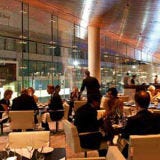
New York
Part of Lincoln Center's grand restoration, Lincoln is a glittering wedge of glass suspended above the clamor of Manhattan street life, soaring out of the plaza next to a reflecting pool and Henry Moore's Reclining Figure. The roof doubles as a grassy park, so when it's sunny, you can get a tan before your meal.
Inside, at night, candlelight glows in shadowy corners, and brightness emanates from the glassed-in kitchen where Jonathan Benno, longtime chef at Thomas Keller's Per Se, has evolved from making New York — Italian cuisine to creating his own vivid interpretations of la cucina italiana moderna, adapted to both the visual drama of the restaurant and the operatic ambience of Lincoln Center itself. (Full disclosure: My son is one of the managers, but that can't keep me from praising it.) The menu changes every night (one constant: Benno's name emblazoned across the front), but recently, his terrine of octopus and pork belly, played off the tanginess of pickled vegetables, dazzled. Fat tortelloni bulged with nettles under a sweet-sour mostarda, walnuts, and salty ricotta salata. And squid ink strozzapreti gained a briny edge from bottarga, capers, and taggiasca olives. There is a great wine list, and Richard Capizzi's superb desserts include warm crostata of pear and cranberry with a muscovado-sugar-and-brown-butter gelato. All that, and my kid saw Tom Cruise and Katie Holmes one night!
142 West Sixty-fifth Street; 212-359-6500; lincolnristorante.com
The Test No. 1

Legal Harborside
By Jed Moran
We called a few of this year's restaurants with fake requests, to put their customer service — and their patience — to the test. Here, our conversation with Legal Harborside in Boston.
Grade: A
ESQ: I just called about a reservation for Saturday, and I wanted to make sure you had a place where I could tie up my falcon.
HOSTESS: [Pause.] I'm sorry, is that a boat?
ESQ: No, no. A bird. I'm a falconer.
HOSTESS: Uh, I'm trying to just think of where we can ...
ESQ: I have these leather things that go over the eyes so he doesn't move around a lot. But he's big.
HOSTESS: Yeah — what we do with pets is have them stay outside on the harbor walk. But I'm not sure if it's legal for him to sit on the pole. Can we put a chair out on the harbor walk? Hopefully his claws are ... the material on our chairs —
ESQ: Well, I can put claw guards on. But this is a champion falcon — it's like a $50,000 falcon. I wanted it to be inside the door.
HOSTESS: If I may ask you to hold just a brief moment?
ESQ: Sure. [Pause.]
MANAGER: Hello? Yes, just for liability purposes — I'm sure you've heard this —
ESQ: What if I paid a server to watch him? I'll buy some entrées for him. You have salmon?
MGR: I just — I wouldn't feel comfortable.
Cotogna
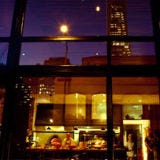
San Francisco
Good Italian food is usually good enough; when things go too fancy, its soul can get lost in translation. A good middle ground appears when an inventive San Francisco chef like Michael Tusk develops a passion for Italian cooking, so that even if his grandmother wasn't Italian, he tries to cook like one. It helps that he has, out his back door, northern California's bounty of meats, seafood, and vegetables.
Eight years ago, Tusk opened the still-red-hot Quince, but Cotogna is more rustic and downright chummy. Every bottle on the wine list is just forty dollars, and — Madon'! — a three-course fixed-price menu runs twenty-four dollars. The pastas are all radiant, from the most delicate fagotelli with ricotta and flowering blossoms to the triangoli with corn and chives. A fearsome rotisserie grill turns out sizzling Gulf prawns with a watermelon panzanella salad. You'd swear Tusk learned all this from his Italian grandmother.
490 Pacific Avenue; 415-775-8508; cotognasf.com
Best New Cookbooks

Esquire: Eat Like a Man
The essential cookbook for men.
American Flavor by Andrew Carmellini
Rediscover what American food is.
Girl in the Kitchen by Stephanie Izard with Heather Shouse
A Top Chef's inspired whimsy.
Cooking My Way Back Home by Mitch Rosenthal
The best cookbook title ever.
Eleven Madison Park by Daniel Humm and Will Guidara
Elaborate and magnificent, like EMP.
My Family Table by John Besh
Father of four cooks big.
Legal Harborside

Boston
The rescue of the Boston waterfront from decrepitude now has an anchor: the three-story Legal Harborside at Liberty Wharf, the largest restaurant in the city. The first level is simply a swankier version of the other thirty-one Legal Sea Foods houses — fish and chips, that kind of thing — but the elegant second floor is something way up the food chain.
"I have young talent champing at the bit to push the envelope on new dishes," says Roger Berkowitz, Legal's CEO. "Here I cut them loose to go after higher-priced seasonal seafood like abalone, more appropriate in fine dining." Order a dark and stormy at the bar and rich lobster soup under a buttery pastry dome. And that rare abalone is sautéed in amontillado sherry and served with lemony risotto and sweet white asparagus. Decked out in the sleek look of a classic ocean liner — or maybe a Kennedy yacht (Ted was a big Legal fan) — with curved rosewood ceilings and black, mastlike columns, the room is perched above the city lights, the quiet harbor, and the dark, faraway ocean. If you find yourself on those waters, sail right in and tie up. The restaurant has its own slip.
270 Northern Avenue; 617-477-2900; legalseafoods.com
The Restaurant Hall of Fame

Tom Colicchio
In 2001, Tom Colicchio had already spent decades working his way from a Jersey seafood joint to helping create the now-iconic Gramercy Tavern. But it was with the arrival of Craft that year that he gave a new vision of fine dining, one stripped of tablecloths and butter sauces, one in which even the lightbulbs went naked. Colicchio wasn't the first chef to shop at green markets and source ingredients impeccably, but he was the first to make the establishment take notice. He now owns restaurants across the country and a bald pate recognizable from Seattle to Savannah. In this role he's redefining another term: chef. He is living proof that being a great contemporary chef can encompass what happens behind a stove as well as away from it: mentoring chefs de cuisine, managing kitchens with the right mix of authority and humor (I know, having once worked for him), advocating for food issues, and inviting the masses watching TV into the world of food. —Elizabeth Gunnison
Frank Stitt
In 1984, when the words Southern and cuisine were rarely used in the same sentence, Esquire named Highlands in Birmingham one of the Best New Restaurants in America. I wrote that chef-owner Frank Stitt's bistro appealed to "the affluent suburban crowds coaxed out of their clubs to come downtown and eat well for a change" — Georgia Bay scallops with basil, for example, and local baked oysters.
Back when Paula Deen was working as a bank teller, Alabama-bred Stitt was already at the forefront of New Southern cuisine. Since then, he's opened two other excellent restaurants and racked up awards. But what he hasn't done is also remarkable: He has not left Alabama, instead staying put to turn out highly personal food that has inspired a wave of Southern chefs. And yet like any great chef — and any true Southerner — he keeps searching for better ways to do things, which means his days of influence are far from over. —John Mariani
Towne Stove and Spirits
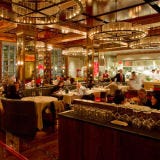
Boston
Two of the most important ingredients in any great restaurant are a passion for the project and attention to detail. Lifelong Bostonian Lydia Shire, chef at Towne, has plenty of both. Here are a few things she loves about her new place: the grand staircase. "It was one of the owners' ideas to add mirrors. Showing off people walking upstairs is just wonderful." The uniforms. "I hate anything that matches." The bar. "A good bar is at the top of a list for a big restaurant. We have three. The street bar in front is the happening place — everyone is young. The second, past the elevators, is locals who want to eat dinner and watch the baseball game. Upstairs is the quiet little boutique bar. We have regulars who will only go upstairs." The photos. "I used to hang out in what's known as the Combat Zone — between Boylston and the theaters. It's kind of seedy, where the hookers worked. The photos were taken in the late sixties and early seventies, on Lagrange Street. It's a side of Boston that's increasingly difficult to find because we've all become holier-than-thou." The lobster popover. "Years ago I came across a green can of Lyle's Golden Syrup. It was better than maple syrup. I made popovers that morning and put the syrup in with butter, and for the opening party for Towne, it occurred to me to put some sherry or booze in them — with lobster." The plates. "They're English: vitrified china and very strong. You'd have to work hard to get them to break."
900 Boylston Street; 617-247-0400; towneboston.com
M. Wells: The Opportunity

It could have been great. Maybe it will be again someday, somewhere else.
By Ryan D'Agostin
The street corner was desolate, at least compared to the kind of corner on which you'd expect to find a buzzy, popular restaurant. The owners, a couple — he the chef, she the hostess and manager — had taken over an old diner. There was a row of dirty stools along the counter, Formica booths, men cooking quickly, close to the patrons. But the food — the food was thrilling. It was always good (the maple pie, the sausage-and-egg sandwich), often great (the Cubano, the egg soufflé with mushroom broth and bonito flakes), and sometimes extraordinary (the escargot with bone marrow, the banana cream pie, the Peking duck with fried rice, followed artfully by a teacup of consommé). The service was a little indifferent, but the high-wire cooking and weird location in an industrial part of Queens, New York, made it one of the most exciting restaurants in recent memory. The half-assed service didn't bother you at first.
M. Wells closed at the end of August after fourteen months. Not for lack of business — seats were always scarce, partly because they only served dinner three nights a week — but because the owners negotiated a shitty lease. Still, its demise felt like the end of something, a symbol of our outgrowing the recent restaurant formula: lovingly crafted comfort food, served by waiters who were too cool for school, in settings that worked very hard to appear haphazard. A $200 haircut designed to look like bed-head. It was a rebellion — a shredding of tablecloths, a smashing of stemware, a melting of matching forks. And it was refreshing at first, then it got a little cute, and then it grew tiresome. Would it kill you to bring the appetizer before the entrée?
M. Wells was kind of great, but it wasn't a "restaurant," because it and its ilk reject much of what makes a restaurant — little things like clearing dirty dishes and negotiating a good lease. They skip the part in which they make you feel as if they're glad you came. And so we hope its death is not a death at all but a turning point, after which dining out can feel more like dining out (without being a bore). No food is so good that you're willing to put up with needless waiting around and indifferent service — a few times, but that's it. Maybe at its next iteration — which, count on it, will be good — you won't have to put up with anything at all.
Tavernita: An Early 2012 Contender

City: Chicago.
Phone: Not yet.
Chef: Ryan Poli.
What it is: A Spanish restaurant in three parts: stand-and-eat pincho bar, main dining room, and late-night eating lounge.
Why it's exciting: Poli is a young and creative chef who can put a restaurant on the map. At least we think so, based on his work at Perennial and for Esquire.
Most intriguing feature: Uruguayan wood-burning grill.
Second-most intriguing feature: Decorative bullheads.
What to expect on your oysters: Melon and tarragon, maybe, or onion marmalade with pickled onions. Definitely not cocktail sauce.
Opening: Later this fall.
Millesime
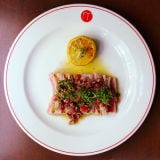
New York
Not since the opening of Balthazar in 1997 has New York seen a true brasserie like the enchanting Millesime. Of bistros the city has plenty, but not big, fast-paced Alsatian brasseries reminiscent of Hemingway haunts along the boulevards of Montparnasse. Millesime exalts classic French seafood, but chef Laurent Manrique adds American flair. First, a tower of shellfish on ice. Quenelles of pike, once a fixture of French dining in New York, are here in all their cream-soaked glory. Then the fun part: You pick a fish: salmon escalope, snapper, etc., and then a sauce: beurre blanc, ginger, etc. Mix and match. The art-nouveau look can never go out of style, and the waitresses' French blouses complete a seductive scene. Linger over cognac and pull out as much of your high school French as you can remember.
92 Madison Avenue; 212-889-7100; millesimerestaurant.com
The Recipe: The Sauce for Every Fish
Sauce vierge (pictured above), by Laurent Manrique
This sauce, called ""virgin"" because it's uncooked, works on any fish, any style.
• 1/2 cup extra-virgin olive oil
• 1 good ripe tomato, diced small
• 1 tbsp sweet onion, like Vidalia, diced small
• 1 tbsp small capers
• 2 tbsp fresh basil, chopped
• 1 tbsp black olives (Moroccan, if possible), diced small
• pulp of 1/4 lemon, diced
• 1 tbsp fresh tarra-gon, chopped
• 1 tbsp fresh chives, chopped
• roasted pine nuts (optional)
Combine ingredients in a bowl 15 minutes before serving so the flavors mix. Spoon over fish. Serves 4.
Dominique's on Magazine
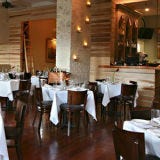
New Orleans
It's been a long, slow climb for New Orleans. Only this year have I found the rollicking spirit of the city palpably restored after the wrenching agonies of Hurricane Katrina, and nowhere is it more evident than in the restaurants that have opened and thrown light into dark neighborhoods. Just drive up Magazine Street outside the French Quarter and you'll see how the dining-room glow draws people for whom letting the good times roll has been very tough.
There you'll find Dominique Macquet's show of faith in his adopted city. He's cooking at a personal-best level attempted too rarely in tradition-bound New Orleans. Flavors from memories of his childhood in Mauritius and his French training coalesce on a menu built almost entirely on Louisiana ingredients. Think shrimp shooters with Kaffir lime, and cured pork belly with fennel and mojito-spiced watermelon. "It's been very challenging to come back," says Macquet. "The city lost 35 percent of the population that ate out. We lost cooks, waiters, dishwashers. Then we had the oil spill. The amazing thing is that now more restaurants have opened than ever before and we're doing good business. But it's not coming from tourists; it's the locals, and they know the new places won't dare charge more than twenty-eight dollars for a main course. New Orleans is one of the great bargain-restaurant cities in America right now." Let the good times roll.
4729 Magazine Street; 504-894-8881; dominiquesneworleans.com


Chefs Reveal What Restaurant Life Is Really Like

Starbucks Is Selling The Most Adorable Keychains

7 Food Network Stars Have Made Millions

7 Things To Know About Being A Private Chef
